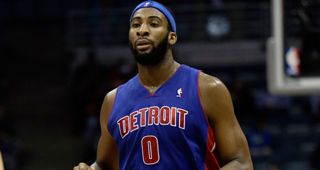In this extremely online age the world resets itself every two weeks, or in an even shorter interval than that, and so recent history is dustier than it used to be. There’s not necessarily more happening now than ever before—even with our current head of state playing an extended Girl Talk set of iconic bad decisions—but we’re cataloguing so much of it that the temporal space between now and 2012 feels, if not more vast than other five-year periods, then at least denser: time like water in a neglected fish tank. Seeing 2012 clearly from here is impossible; it’s only a dark shape casting its shadow through the grime.
Which is all to say, of course, that Andre Drummond was drafted into a much different NBA than the one he currently inhabits. In 2012, the dominant traditional big man was still a thriving, if soon-doomed archetype. Dwight Howard was right at the MVP-contending end of what would turn out to be his premature prime. Roy Hibbert had just made an All-Star appearance almost by sheer dint of his space-eating capabilities and was the defensive backbone of a Pacers team that gave LeBron’s Heat some trouble. The Mavs’ second-best player when they beat the Heat in the 2011 Finals was Tyson Chandler. The Lakers had only a couple years hence won back-to-back titles with a front line tandem of Andrew Bynum and Pau Gasol. The team-building maxim that, if given the opportunity, you snap up a talented seven-footer every time, still held.
The reason Drummond fell to the Pistons at nine in the 2012 draft wasn’t doubts over whether he could play in the then-state-of-the-art NBA offenses and defenses, but whether he could be bothered to play hard. Drummond was widely thought of as a possible number one pick when he committed to UConn out of St. Thomas More. He had almost everything you could want from a player his age: massive size, a nose for rebounds, shocking quickness, a powerful if unpolished post game. What caused some NBA front offices to sour on him as a prospect is that, in his one year at the college level, he tended to flit in and out of games. This happens to young big men sometimes because they don’t have suitably intelligent guards to get them the ball or because unimaginative coaches can’t scheme ways to get them open on the block. Drummond was a victim of that to a certain extent, but he also flatly didn’t show up some nights. His rebound numbers were all over the place night-to-night. His interest in guarding the paint was fickle. When UConn crashed out of the NCAA tournament in the opening round of his first and only season in Mansfield, he was fully checked out: four shots, two points, four rebounds, and five fouls. His draft stock justifiably took a hit.
Drummond has pleasantly surprised everyone by reliably showing up and doing his job as a professional player. His work ethic doesn’t inspire raves, but he doesn’t mind doing the unglamorous stuff that big men are often tasked with. During his rookie year, Lawrence Frank called him “maybe our best screener” and Drummond has been consistently near the top of the league in rebounding numbers for most of his career. Last season, he showed up having dropped twenty pounds over the summer, and early indications this year are that he’s overcoming the free throw line yips that used to keep him off the court late in close games. Drummond has his flaws—his defensive positioning isn’t great; he picks up some stupid fouls—but he certainly isn’t lazy or unengaged. In fact, as recently as a couple of seasons ago, there were signs that Stan Van Gundy was steadily turning Drummond into an upper-middle class man’s Dwight Howard.
That promise evaporated swiftly when Drummond had some serious struggles last year. He was gallingly inconsistent from night to night—thirteen games with twenty points or more, fifteen with eight or less—and, as Spencer Lund pointed out in January, his pick-and-roll defense was often atrocious. Somehow, his post-ups were even worse. The Pistons shopped him around. Over the last sixteen contests of the season, while Detroit were trying to muster a late playoff push, Drummond’s confidence imploded and he played like a backup, averaging less than a block and 8.6 points per game on 47.7 percent shooting.
He looked broken and lost. Like maybe Van Gundy had given him responsibilities he couldn’t handle and it caused him to regress. Or maybe Drummond, in a smaller, more skill-dependent league where big men have to be exceptional to stay on the floor for extended periods of time, simply wasn’t exceptional: just an okay player who would have been way more effective in the era that’s on its way out.
We’re not even a quarter into the new season, but it appears Drummond hasn’t let a bad year sink him. We’ll see how those shiny new free throw shooting numbers hold up—63 percent! That’s Gary Trent-level charity stripe proficiency!—but he’s thankfully ditched his probably unsalvageable back-to-the-basket game and moved out to the elbow, where he’s hitting baseline cutters and creating open jumpers for teammates with dribble hand-offs while also subsisting on his usual diet of putbacks and screen-and-roll dunks. It’s true that the Pistons are simply playing much better around Drummond than they did last season—Reggie Jackson being fully healthy for the first time in a while helps a lot—and that Drummond’s defense still leaves a lot to be desired, but he once again is playing like a vital and exceedingly necessary part of what’s currently a fun and competitive Detroit team. He’s found the path after losing it, which is no small thing. We’ve seen fragile young big men impress initially, sputter, and never recover. Roy Hibbert is thirty and Larry Sanders is twenty-eight. They’re both out of the league.
Andre Drummond isn’t likely to become a superstar. He’s in his mid-twenties, and though he has some growing to do, he won’t ever be able to take over games like Anthony Davis does on offense, or Marc Gasol does on both ends of the floor. Some of this is down to Drummond’s deficiencies, but some of it is a league that he’s not particularly well-suited for, and it’s to his credit that he’s continuing to add to his game by demonstrating precisely what scouts were worried he lacked when he came out of college. He’s been coachable, kept plugging away through low periods, and seemed genuinely invested in improving himself. He has cared, in other words, which is all that was ever standing between Drummond and success. If it’s not the NBA-demolishing success we might have imagined for him in 2012—well, what is he supposed to do about that? He didn’t know Draymond Green was a center, or that Giannis Antetokounmpo was coming, and neither did anybody else. Drummond has admirably controlled what he can, and it’s inspiring in that peculiar way hard-won, not-quite-triumphant feats are. He’s constructing his best self, if not an ideal one, and sometimes—most of time—that’s just the way things go. It doesn’t render the work any less worthy.



